Significance of Screen Time

These days, American children are more wired than ever – and the dramatic increase in their screen time could be wreaking havoc on their mental and physical health. An estimated 18.5 percent of all children and adolescents are obese, according to the Centers for Disease Control and Prevention (CDC), which is more than triple the rate of the 1970s. Meanwhile, experts are beginning to realize that children who limit their screen time to two hours a day have better mental health outcomes.
Scientists have been linking obesity and screen time for several years – yet most children in the United States likely have to spend some time with technology on a daily basis. In much of the country, homework and other school activities likely require time with computers or other media devices, especially in today’s digital age. But how much screen time might be too much?
We set out to further understand the connections between obesity, screen time, and other negative health outcomes in American youths. We evaluated survey data from 59,000 people collected by the CDC’s Youth Risk Behavior Surveillance System (YRBSS) between 2011 and 2017. In the process, we’ve asked some intriguing questions: Is screen time linked to other adverse health behaviors, such as sleeping too little or drinking too much soda? How is excessive screen time potentially affecting children’s behavior – at school and at home? Are children encountering cyberbullying at greater rates if they spend more time in front of smartphones, televisions, and computers? Read more to find out how new-age media and increasing time in front of screens is impacting the future of America.
Television and computer use
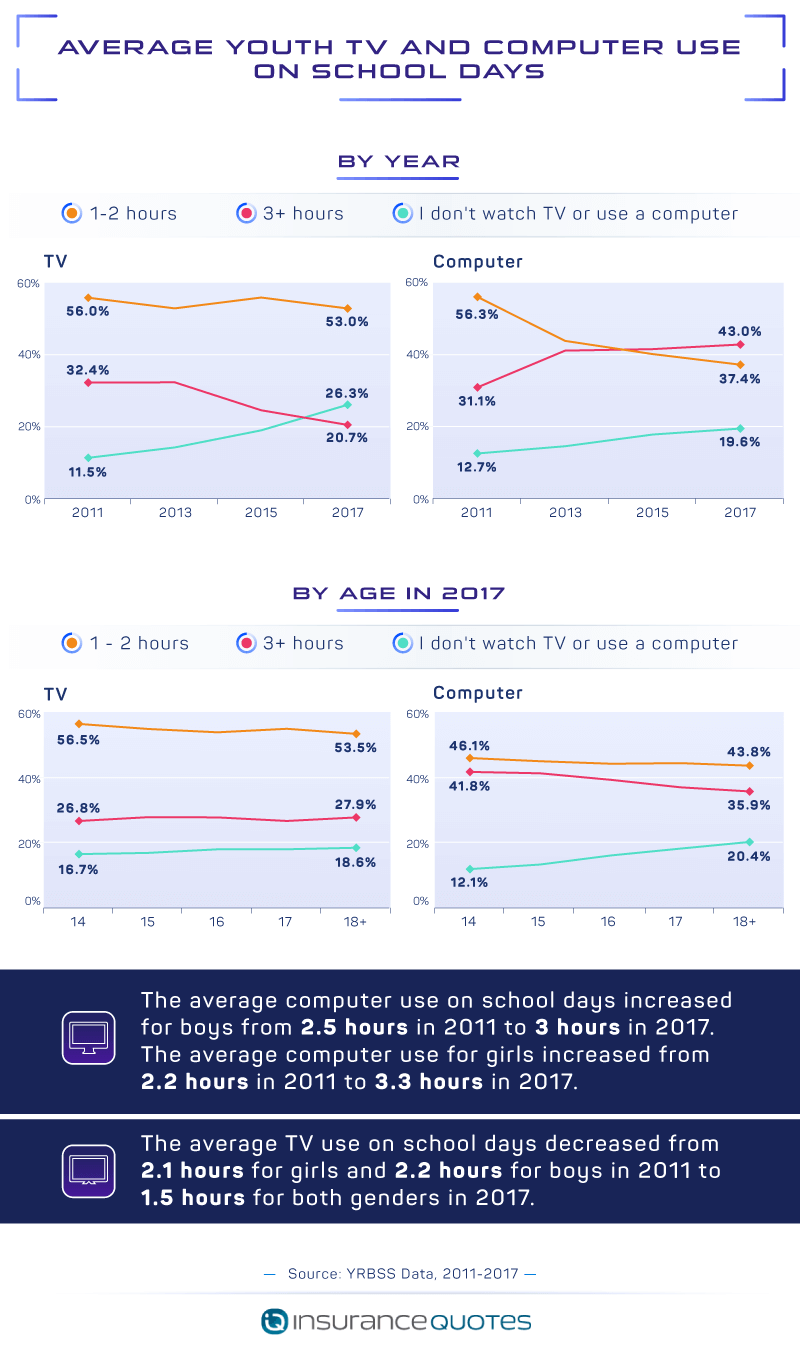
In the 1970s, American children typically had fewer entertainment options: maybe a few television shows they liked, some simple gameplay on the Atari, but a lot of opportunities to play outdoors. It’s not all that surprising they ran about a minute and a half faster, were 15 percent more fit, and were less obese.
We examined the survey respondents’ time in front of the television – a legacy media form – versus the computer. According to the data, the overall percentage of children watching three hours or more of television has decreased from 32.4 percent in 2011 to 20.7 percent in 2017. However, computer use has increased from 31.1 percent to 43 percent in the same time period. Among those surveyed, the percentage of people who watched a lot of TV – more than three hours a day – or none at all increased slightly with age. Meanwhile, computer use decreased with age. One of the most significant takeaways? While children may be watching less television, they are possibly replacing that time with computer use.
Old-school vs. high-tech
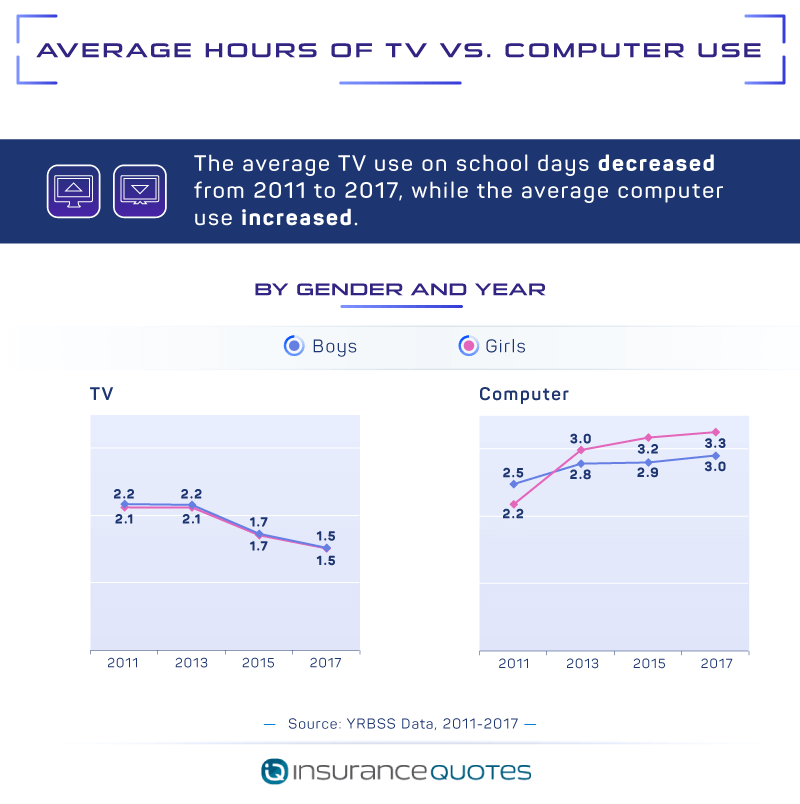
With a decline in TV viewership among the younger generations, it’s easy to assume children are getting less screen time these days. However, our data suggest that this isn’t true – kids are just spending time in front of different types of screens than before. Between 2011 and 2017, the average number of hours boys and girls spent watching TV generally declined from roughly 2.2 hours a day to 1.5 hours a day. However, computer time increased during this same period. In 2011, for example, girls spent an average of 2.2 hours in front of computers per day. By 2017, that number reached 3.3 (boys, on the other hand, increased from 2.5 hours in 2011 to 3 in 2017).
State of screen time
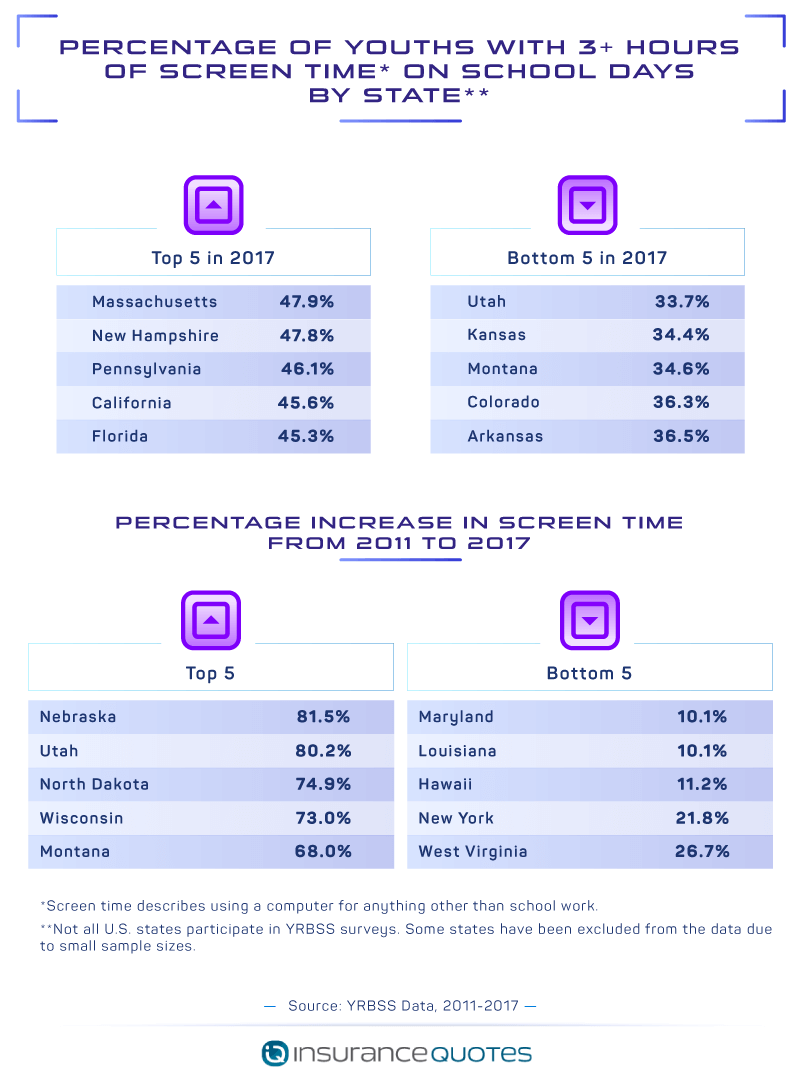
The youth obesity epidemic is a nationwide issue for the United States, but some areas are more obese than others – hence why researchers continue to search for the links between geography, neighborhood design, and waistlines in America. To add to this robust area of research, we examined the percentage of American youths who spend three hours or more in front of computer screens each school day. Our findings suggest that Massachusetts, New Hampshire, Pennsylvania, California, and Florida all have the highest rate of children watching screens for three hours or more per school day, while Arkansas, Colorado, Montana, Kansas, and Utah have the lowest rates. This could be a key takeaway for individual state policies since some geographic regions are associated with greater screen time and perhaps a more sedentary lifestyle.
Screen time and weight
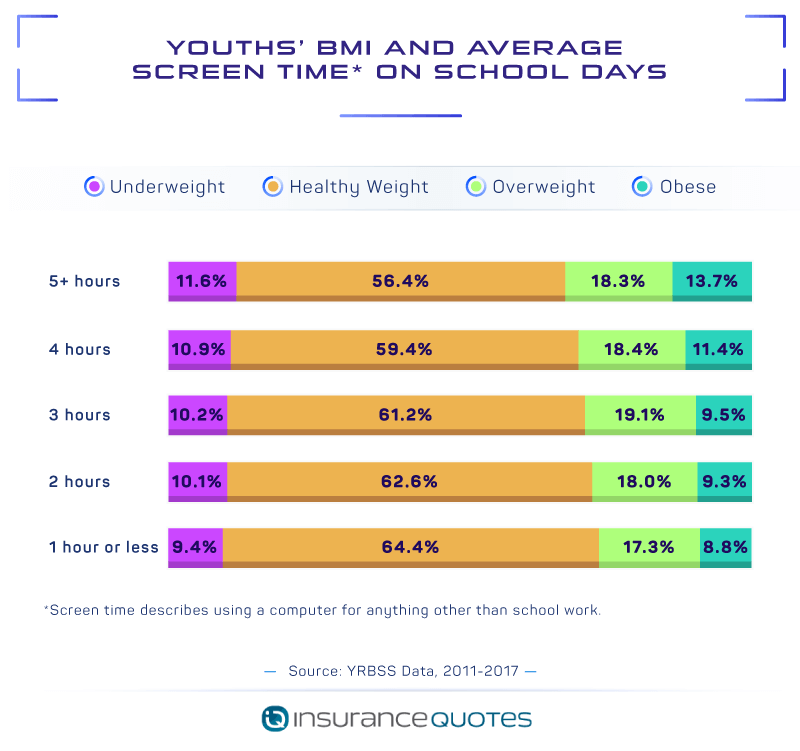
We analyzed data from the CDC for possible links between various amounts of screen time and weight. The differences were moderate but telling: Extreme weight categories such as clinical obesity or an underweight body mass index (BMI) was most prevalent among children who spent the most time in front of computer screens – five hours or more. The data sample with the least screen time (one hour or less) typically had the highest percentage of children at a healthy weight. In general, our data suggest that groups with three or more hours in front of computer screens daily equated to higher percentages of overweight or obese children. Though this data does not prove a cause-and-effect relationship between weight and screen time, the correlation provides an important glimpse at how adding or reducing a few hours of screen time may positively or negatively impact a child’s weight.
Is it healthy?
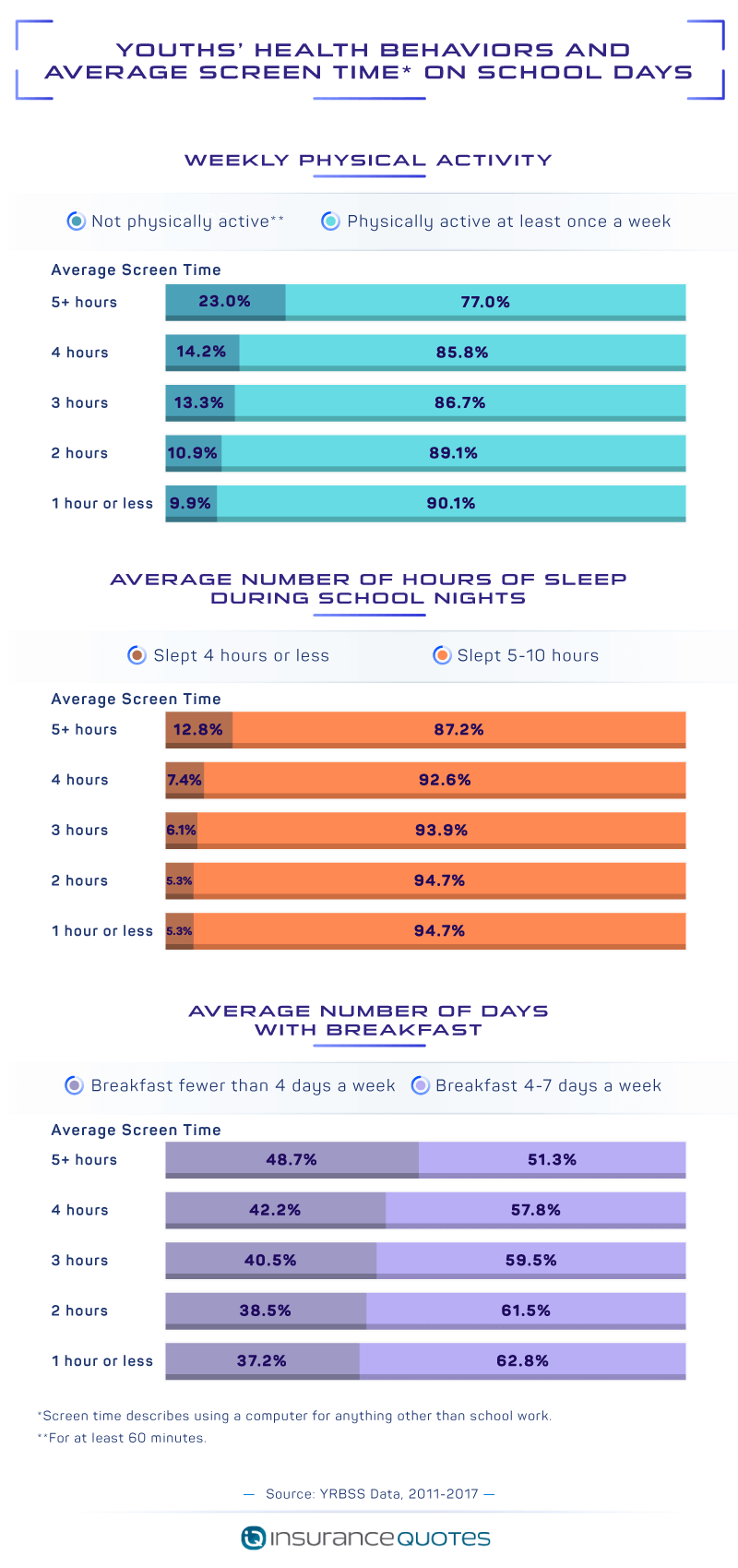
Our data analysis suggests that excessive screen time isn’t just about a lack of exercise – it’s linked to a list of other destructive health habits, too. We examined survey data to see how children’s screen time correlates to their ability to nourish themselves with healthy foods throughout the day. Too much time in front of a screen could be influencing America’s children in more ways than we realize.
The more time spent in front of screens, the less likely children and teens are to be physically active for at least 60 minutes a day. More than 90 percent of all children with one hour or less of screen time per day also got an hour of exercise, compared to 77 percent of children who spent five or more hours with screens. Additionally, children with high screen times get less sleep on average during school nights. Nearly 95 percent of children who spent an hour or less in front of screens got at least five hours of sleep, according to our analysis, compared to 87.2 percent of children who consumed five hours or more of screen time a day. In other words, 12.8 percent of children with very excessive screen time (five or more hours a day) got four hours or less of sleep. That’s an incredibly important takeaway for public health officials and policymakers – the National Sleep Foundation recommends that school-aged children get 9 to 11 hours of shut-eye every night.
Screen time comparison
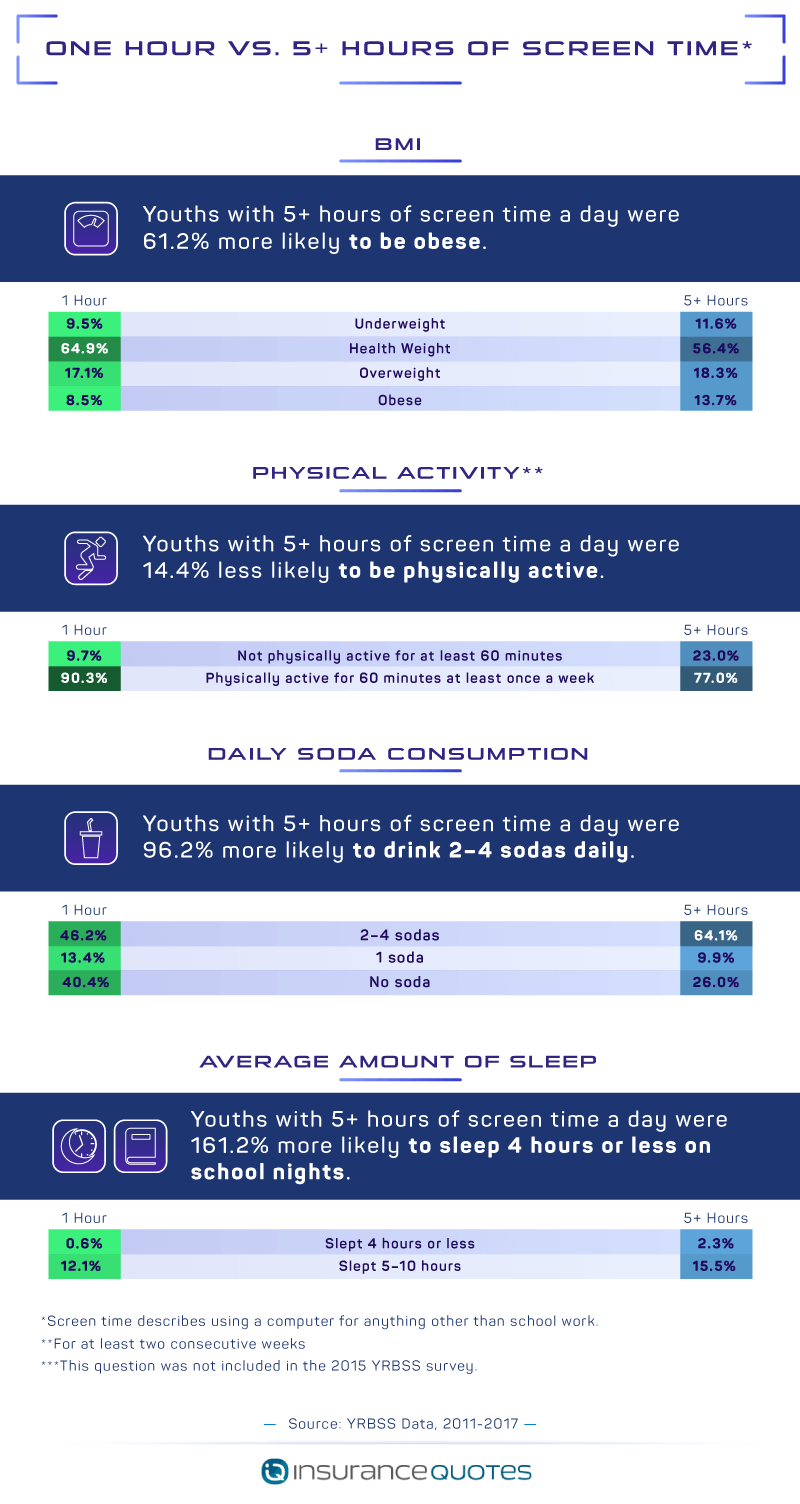
Perhaps one of the best ways to examine the relationship between screen time and obesity is to compare extreme differences – in this case, children who get one hour or less of screen time per day versus those who get five hours or more.
Our findings suggest that high amounts of screen time are correlated with less physical activity and more soda consumption – a well-known recipe for obesity. Children in the high screen time cohort were 61.2 percent more likely to be obese, and only 77 percent of them got an hour of exercise during the week (compared to 90.3 percent of children with an hour or less of screen time). Moreover, kids in the high screen time group were 96.2 percent more likely to drink two to four sodas a day, though soda consumption was still as high as 46.2 percent among the low screen time group.
Screen time and violence
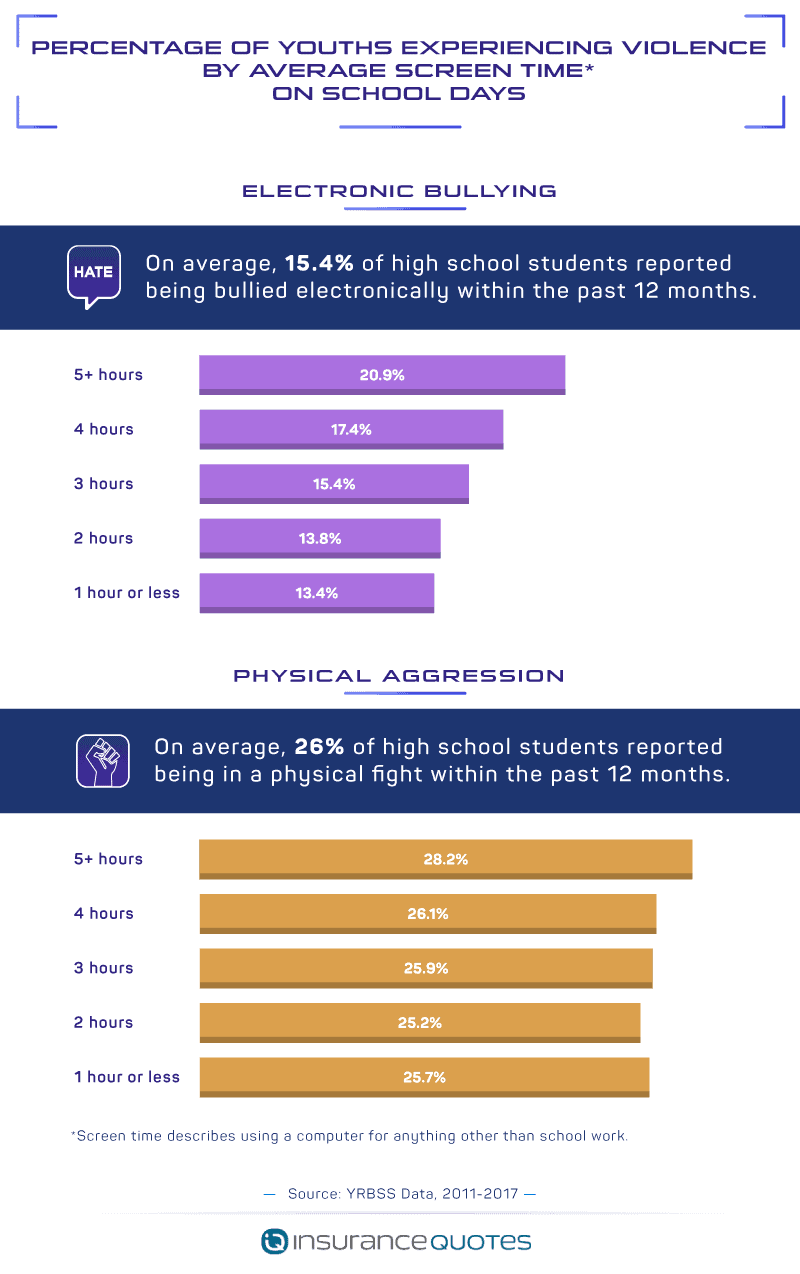
Some have speculated that excessive screen time makes kids “moody, crazy and lazy.” In some sense, that may be true. After analyzing the CDC data, we found that the percentage of children who had experienced electronic bullying or had been in a fight generally increased with screen time. Children with one hour or less of screen time, for example, report being cyberbullied at a rate of only 13.4 percent. That’s significantly less than those who spend five or more hours in front of a screen a day – 20.9 percent of those children reported crossing paths with electronic bullying.
When it comes to physical fights, however, the differences are more modest: More than 28 percent of children in the highest cohort of screen time (five hours or more) have been in a physical altercation, compared to 25.7 percent of those who consume one hour or less.
Screen Time and Mental Health
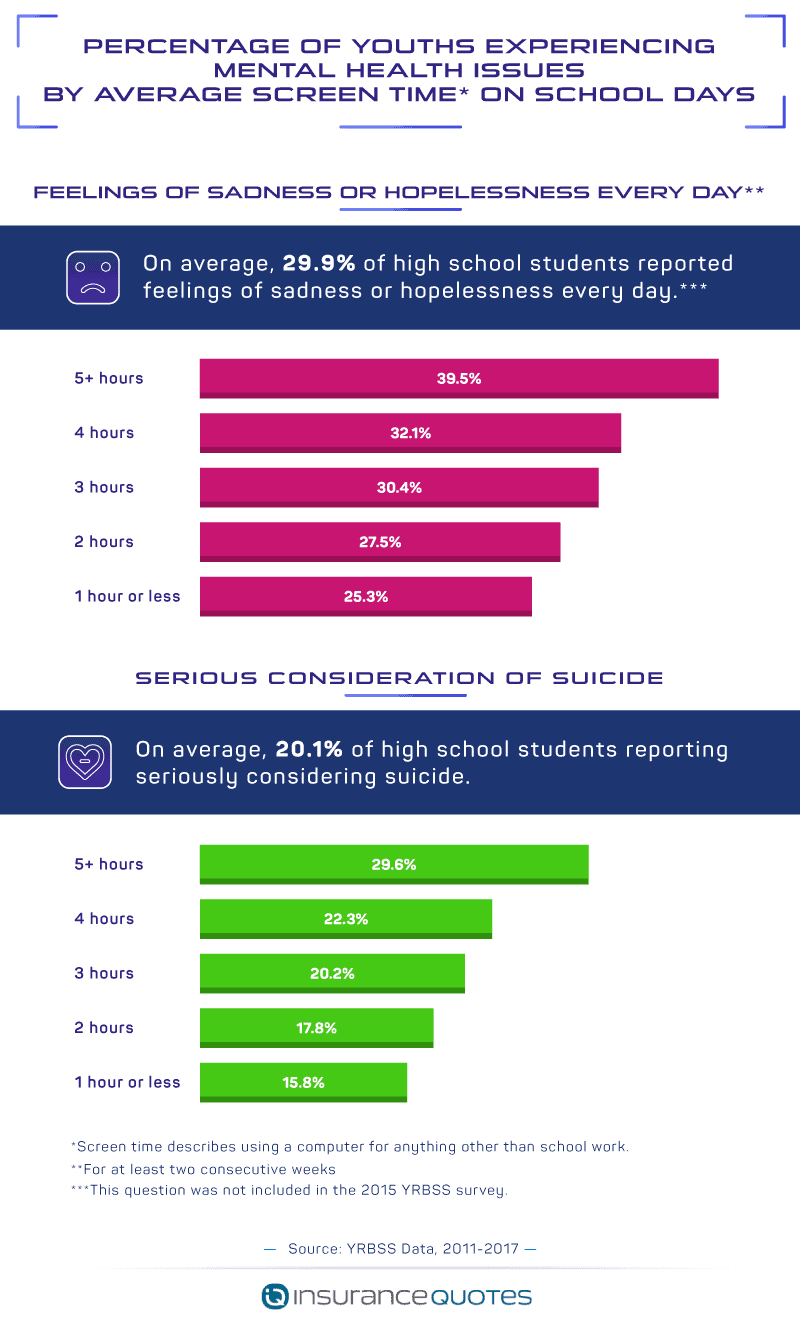
Beyond obesity, children around the United States are struggling with mental health issues too often. Death by suicide has been on the rise in children aged 12 and under, along with depression rates among those aged 12 to 17. We examined CDC data in search of possible connections between screen time and depressive symptoms or thoughts of suicide.
Our results suggest that children with large amounts of screen time are more likely to report suicidal thoughts as well as depressive symptoms. Nearly 40 percent of children who consumed five hours or more of screen time a day reported feeling sad or hopeless for two consecutive weeks, compared to 25.3 percent of children who consumed one hour or less. Nearly 30 percent of children with at least five hours of daily screen time also experienced serious thoughts of suicide, compared to 15.8 percent of those who used screens for one hour or less.
These are not cause-and-effect relationships, but rather correlations. Even so, our findings suggest that mental health professionals and parents should pay attention to how much time their kids spend in front of computers and other screens.
Conclusion
Our study gives key insight into the potentially devastating effects of excessive screen time on children’s lives. While TV, computer, phone, and tablet screens no doubt give children greater access to a wealth of information in the modern age, our study suggests that too much time engaged with these devices can yield adverse effects as well. Kids who spend several hours a day with screens are more likely to drink soda, feel depressed or suicidal, experience electronic bullying, lack sleep, and live with obesity. These links, calculated using recent data from 59,000 people surveyed by the CDC, paint a disturbing picture of how a modern-day cultural phenomenon could alter future generations of America for the worse.
To learn more about screen time, the obesity crisis, and its potential effects on health insurance policies, please visit .
Methodology
For this project, we evaluated survey data from the Centers for Disease Control and Prevention’s (CDC) Youth Risk Behavior Surveillance System (YRBSS) from 2011 to 2017. With a focus on computer use, we examined the data for correlations between screen time and youth health factors, such as sleep, physical exercise, and weight. From 2011 to 2017, the CDC gathered data from over 59,000 survey respondents through YRBSS surveys. No statistical testing was used during the production of this project.
Computer use in the YRBSS data is defined as using a computer for anything other than school-related purposes.
The term “screen time” in this project describes using a computer for anything other than school work. It does not include television viewing.
Sources
https://www.cdc.gov/obesity/data/childhood.html
https://www.cdc.gov/healthyschools/obesity/facts.htm
https://www.seattletimes.com/seattle-news/politics/first-lady-praises-pushes-food-industry/
http://www.sciencemag.org/news/2018/08/artificial-intelligence-spots-obesity-space
https://www.sleepfoundation.org/excessivesleepiness/content/how-much-sleep-do-babies-and-kids-need
https://www.cdc.gov/childrensmentalhealth/data.html
https://www.refinery29.com/2017/11/179445/depression-on-rise-united-states-youth
Fair Use Statement
Do you want to share our findings on screen time and health factors across the web? You’re in luck! Feel free to share it as much as you’d like, but please link back to this page. The graphics and information found on this website are available for noncommercial reuse only.
